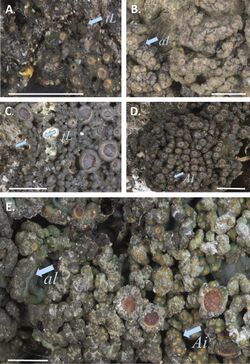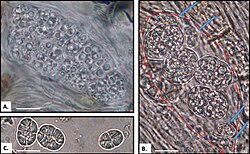Biology:Rostania
| Rostania | |
|---|---|

| |
| Thalli and apothecia of several Rostania spp: A: R. occultata var. populina B: R. multipunctata C: R. ceranisca D: R. laevispora E: R. callibotrys. Scale bar: 1 cm. | |
| Scientific classification | |
| Domain: | Eukaryota |
| Kingdom: | Fungi |
| Division: | Ascomycota |
| Class: | Lecanoromycetes |
| Order: | Peltigerales |
| Family: | Collemataceae |
| Genus: | Rostania Trevis. (1880) |
| Type species | |
| Rostania quadrata (J.Lahm ex Körb.) Trevis. (1880)
| |
| Species | |
|
R. callibotrys | |
Rostania is a genus of lichen-forming fungi in the family Collemataceae.[1][2] These lichens are primarily found on tree bark, occasionally on wood, with one species known to inhabit soil. The genus is characterized morphologically by having minute thalli made of hyphal tissue without a separate [[Glossary of lichen terms#{{biology:{1}}}|{{Biology:{1}}}]], and the more or less cuboid-shaped [[Glossary of lichen terms#{{biology:{1}}}|{{Biology:{1}}}]].[3]
Taxonomy
The genus was originally circumscribed in 1880 by Italian botanist Vittore Benedetto Antonio Trevisan de Saint-Léon.[4]
In its new, restricted sense, following its revision using molecular phylogenetics and subsequent resurrection,[5] Rostania is equivalent to the Collema occultatum group as defined by Gunnar Degelius in 1954.[6] The taxonomy of the non-monophyletic taxon Rostania occultata is recently been clarified, and revised generic limitations of the genus proposed, such that some species have been excluded and transferred to other genera.[7]
Description
Rostania features lichens with a somewhat crustose to [[Glossary of lichen terms#{{biology:{1}}}|minutely foliose]] thallus that is relatively small, measuring 0.3 to 2.5 cm (0.1 to 1.0 in) in diameter. These lichens exhibit dark olive green, black, or brownish colours and can either form a diffuse granular crust or have poorly developed [[Glossary of lichen terms#{{biology:{1}}}|{{Biology:{1}}}]] up to 1 or 2 mm wide. The lobes are smooth to ridged and lack a true [[Glossary of lichen terms#{{biology:{1}}}|{{Biology:{1}}}]]. The medulla consists of hyphal structures intermingled with chains of Nostoc photobiont cells; a [[Glossary of lichen terms#{{biology:{1}}}|{{Biology:{1}}}]] is absent in Rostania species.[3]

A: R. occultata var. populina, cubic spores B: R. ceranisca, oblong spores; ascus (red line) with only four mature spores visible but remnants of four aborted spores can be seen (arrows) C: R. callibotrys, oblong spores. Scale bar: 10 µm.
Isidia are not present in this genus; however, accessory teretiform [[Glossary of lichen terms#{{biology:{1}}}|{{Biology:{1}}}]] (i.e., small, cylindrical extensions) may develop from [[Glossary of lichen terms#{{biology:{1}}}|{{Biology:{1}}}]]. The apothecia are [[Glossary of lichen terms#{{biology:{1}}}|{{Biology:{1}}}]], sessile, and [[Glossary of lichen terms#{{biology:{1}}}|{{Biology:{1}}}]], resembling [[Glossary of lichen terms#{{biology:{1}}}|{{Biology:{1}}}]] in their early stages. The [[Glossary of lichen terms#{{biology:{1}}}|{{Biology:{1}}}]] colour ranges from very pale brownish to dark red-brown. The [[Glossary of lichen terms#{{biology:{1}}}|{{Biology:{1}}}]] is distinct and smooth, either entire or [[Glossary of lichen terms#{{biology:{1}}}|{{Biology:{1}}}]], and may become excluded over time. The [[Glossary of lichen terms#{{biology:{1}}}|{{Biology:{1}}}]] is colourless to reddish-brown and does not react with a solution of potassium hydroxide or ammonia. The hymenium is colourless and turns blue when exposed to iodine. The [[Glossary of lichen terms#{{biology:{1}}}|{{Biology:{1}}}]] is shallow, either colourless or pale yellowish.[3]
The [[Glossary of lichen terms#{{biology:{1}}}|{{Biology:{1}}}]] comprises numerous, [[Glossary of lichen terms#{{biology:{1}}}|{{Biology:{1}}}]] paraphyses that are mostly unbranched, with somewhat swollen apices. The asci are clavate and contain two, four, or eight spores, with the wall and [[Glossary of lichen terms#{{biology:{1}}}|apical dome]] turning blue in response to potassium hydroxide and iodine. The ascospores are broadly cylindrical to more or less spherical, often cuboid, and [[Glossary of lichen terms#{{biology:{1}}}|{{Biology:{1}}}]]. [[Glossary of lichen terms#{{biology:{1}}}|{{Biology:{1}}}]] may be present in some species, embedded within the thallus. The conidia are [[Glossary of lichen terms#{{biology:{1}}}|{{Biology:{1}}}]] and hyaline. No lichen products have been detected in Rostania species using thin-layer chromatography.[3]
Species
(As of April 2023), Species Fungorum (in the Catalogue of Life) accepts 9 species of Rostania.[1]
- Rostania callibotrys (Tuck.) Otálora, P.M.Jørg. & Wedin (2013)
- Rostania ceranisca (Nyl.) Otálora, P.M.Jørg. & Wedin (2013)
- Rostania coccophylla (Nyl.) Otálora, P.M.Jørg. & Wedin (2013)
- Rostania effusa A.Košuth., M.Westb. & Wedin (2022)[8]
- Rostania laevispora (Swinscow & Krog) Otálora, P.M.Jørg. & Wedin (2013)
- Rostania multipunctata (Degel.) Otálora, P.M.Jørg. & Wedin (2013)
- Rostania pallida A.Košuth., M.Westb. & Wedin (2022)[8]
- Rostania occultata (Bagl.) Otálora, P.M.Jørg. & Wedin (2013)
- Rostania populina (Th.Fr.) A.Košuth., M.Westb. & Wedin (2022)[8]
Because Rostania callibotrys does not group with Rostania in molecular phylogenetic analysis (instead forming an unsupported group with Enchylium), Košuthová and colleagues suggest that its placement in this genus is uncertain. Rostania laevispora is rarely collected and has not yet had its DNA analysed, but its morphology suggests a close relationship with R. callibotrys. Another seldom-collected species, R. coccophylla, may be better placed in the genus Collema.[7]
The taxon once known as Rostania quadrifida (D.F.Stone & McCune) McCune (2014) is now Scytinium quadrifidum.[9] Rostania paramensis (P.M.Jørg. & Palice) P.M.Jørg. & Palice (2015) was transferred to Leptogium, as Leptogium paramense.[7]
References
- ↑ 1.0 1.1 "Rostania". Species 2000: Naturalis, Leiden, the Netherlands. https://www.catalogueoflife.org/data/taxon/6447G.
- ↑ Wijayawardene, N.N.; Hyde, K.D.; Dai, D.Q.; Sánchez-García, M.; Goto, B.T.; Saxena, R.K. et al. (2022). "Outline of Fungi and fungus-like taxa – 2021". Mycosphere 13 (1): 53–453. doi:10.5943/mycosphere/13/1/2. https://www.researchgate.net/publication/358798332.
- ↑ 3.0 3.1 3.2 3.3 Cannon, Paul; Otálora, Mónica A.G.; Košuthová, Alica; Wedin, Mats; Aptroot, André; Coppins, Brian; Simkin, Janet (2020). "Peltigerales: Collemataceae, including the genera Blennothallia, Callome, Collema, Enchylium, Epiphloea, Lathagrium, Leptogium, Pseudoleptogium, Rostania and Scytinium". Revisions of British and Irish Lichens 2: 1–38 [27]. doi:10.34885/174.

- ↑ Trevisan, V.B.A. (1880). "Sulle Garovaglinee, nuovo tribu di Collemacee" (in it). Rendiconti dell'Istituto Lombardo di Scienze e Lettere Scienze Biologiche 13 (3): 65–77.
- ↑ Otálora, Mónica A. G.; Jørgensen, Per M.; Wedin, Mats (2013). "A revised generic classification of the jelly lichens, Collemataceae". Fungal Diversity 64 (1): 275–293. doi:10.1007/s13225-013-0266-1. http://urn.kb.se/resolve?urn=urn:nbn:se:nrm:diva-184.
- ↑ Degelius, G. (1954). "The lichen genus Collema in Europe". Symbolae Botanicae Upsalienses 13 (2): 1–499.
- ↑ 7.0 7.1 7.2 Košuthová, Alica; Westberg, Martin; Otálora, Mónica A.G.; Wedin, Mats (2019). "Rostania revised: testing generic delimitations in Collemataceae (Peltigerales, Lecanoromycetes)". MycoKeys 47 (47): 17–33. doi:10.3897/mycokeys.47.32227. PMID 30820165.
- ↑ 8.0 8.1 8.2 Košuthová, Alica; Westberg, Martin; Wedin, Mats (2022). "A revision of the Rostania occultata (Collemataceae) complex in Fennoscandia". The Lichenologist 54 (1): 13–24. doi:10.1017/s0024282921000487.
- ↑ "Record Details: Rostania quadrifida (D.F. Stone & McCune) McCune, Montana Lichens: An Annotated List 2: 139 (2014)". Index Fungorum. https://www.indexfungorum.org/names/NamesRecord.asp?RecordID=809881.
Wikidata ☰ Q23072882 entry
 |

